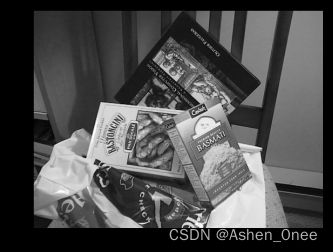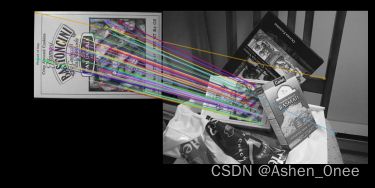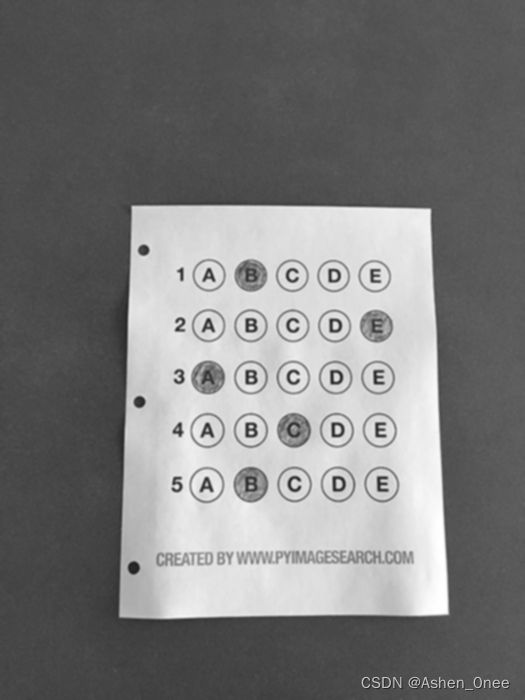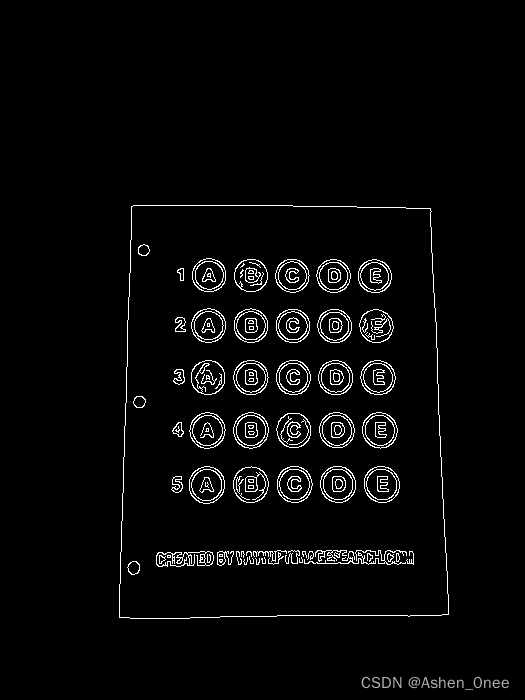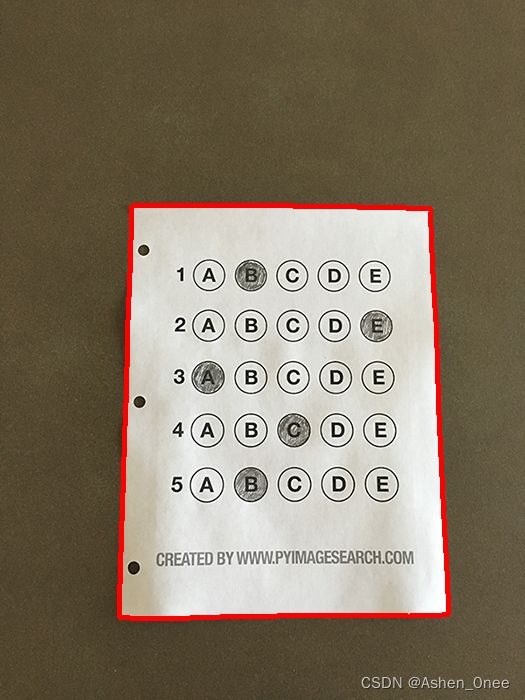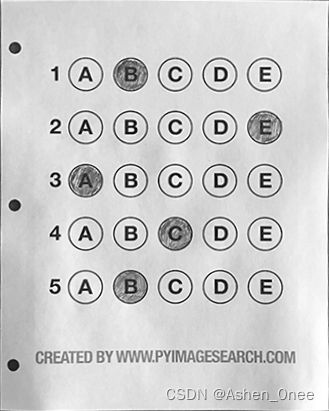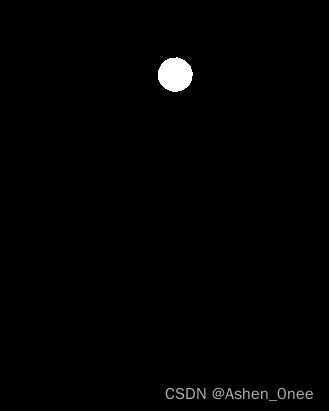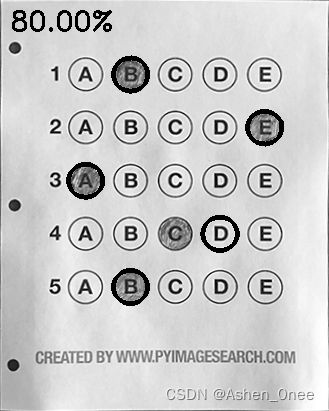12月19日 OpenCV 实战基础学习笔记——特征匹配
文章目录
- 前言
- 一、特征匹配
-
- 1、Brute-force 蛮力匹配
- 2、1 对 1 匹配
- 3、k 对最佳匹配
- 二、答题卡识别
前言
本文为12月19日 OpenCV 实战基础学习笔记——特征匹配,分为两个章节:
- 特征匹配;
- 答题卡识别。
一、特征匹配
1、Brute-force 蛮力匹配
import cv2 as cv
import numpy as np
import matplotlib.pyplot as plt
img1 = cv.imread("./ImageStich/box.png", 0)
img2 = cv.imread("./ImageStich/box_in_scene.png", 0)
plt.imshow(img1, cmap="gray")
plt.imshow(img2, cmap="gray")
sift = cv.SIFT_create()
kp1, des1 = sift.detectAndCompute(img1, None)
kp2, des2 = sift.detectAndCompute(img2, None)
- crossCheck: 两个特征点要互相匹配。例如 A 中的第 i 个特征点与 B 中的第 j 个特征点最近的,并且 B 中的第 j 个特征点到 A 中的第 i 个特征点也是。
# NORM_L2: 归一化数组的(欧几里德距离),如果其他特征计算方法需要考虑不同的匹配计算方式
bf = cv.BFMatcher(crossCheck=True)
2、1 对 1 匹配
matches = bf.match(des1, des2)
matches = sorted(matches, key=lambda x: x.distance)
img3 = cv.drawMatches(img1, kp1, img2, kp2, matches[:10], None, flags=2)
plt.imshow(img3, cmap="gray")
3、k 对最佳匹配
bf = cv.BFMatcher()
matches = bf.knnMatch(des1, des2, k=2)
good = []
for m, n in matches:
if m.distance < 0.75 * n.distance:
good.append([m])
img3 = cv.drawMatchesKnn(img1, kp1, img2, kp2, good, None, flags=2)
plt.imshow(img3)
二、答题卡识别
import numpy as np
import cv2 as cv
# 正确答案
ANSWER_KEY = {0: 1, 1: 4, 2: 0, 3: 3, 4: 1}
def order_points(pts):
# 4 个坐标点
rect = np.zeros((4, 2), dtype='float32')
# 按顺序找到对应坐标0123分别是 左上,右上,右下,左下
# 计算左上,右下
s = pts.sum(axis=1)
rect[0] = pts[np.argmin(s)]
rect[2] = pts[np.argmax(s)]
# 计算右上和左下
diff = np.diff(pts, axis=1)
rect[1] = pts[np.argmin(diff)]
rect[3] = pts[np.argmax(diff)]
return rect
def four_point_transform(image, pts):
# 获取输入坐标点
rect = order_points(pts)
(tl, tr, br, bl) = rect
# 计算输入的w和h值
widthA = np.sqrt(((br[0] - bl[0]) ** 2) + ((br[1] - bl[1]) ** 2))
widthB = np.sqrt(((tr[0] - tl[0]) ** 2) + ((tr[1] - tl[1]) ** 2))
maxWidth = max(int(widthA), int(widthB))
heightA = np.sqrt(((tr[0] - br[0]) ** 2) + ((tr[1] - br[1]) ** 2))
heightB = np.sqrt(((tl[0] - bl[0]) ** 2) + ((tl[1] - bl[1]) ** 2))
maxHeight = max(int(heightA), int(heightB))
# 变换后对应坐标位置
dst = np.array([
[0, 0],
[maxWidth - 1, 0],
[maxWidth - 1, maxHeight - 1],
[0, maxHeight - 1]], dtype='float32')
# 计算变换矩阵
M = cv.getPerspectiveTransform(rect, dst)
warped = cv.warpPerspective(image, M, (maxWidth, maxHeight))
# 返回变换后的结果
return warped
def sort_contours(cnts, method='left-to-right'):
reverse = False
i = 0
if method == "right-to-left" or method == "bottom-to-top":
reverse = True
if method == "top-to-bottom" or method == "bottom-to-top":
i = 1
boundingBoxes = [cv.boundingRect(c) for c in cnts]
(cnts, boundingBoxes) = zip(*sorted(zip(cnts, boundingBoxes),
key=lambda b: b[1][i], reverse=reverse))
return cnts, boundingBoxes
def cv_show(name, img):
cv.imshow(name, img)
cv.waitKey(0)
cv.destroyAllWindows()
# 预处理
img = cv.imread("./answer sheet/images/test_01.png")
img_contours = img.copy()
img_gray = cv.cvtColor(img, cv.COLOR_BGR2GRAY)
img_blur = cv.GaussianBlur(img_gray, (5, 5), 0)
cv_show("Blurred", img_blur)
img_edged = cv.Canny(img_blur, 75, 200)
cv_show("Edged", img_edged)
# 轮廓检测
cnts = cv.findContours(img_edged.copy(), cv.RETR_EXTERNAL, cv.CHAIN_APPROX_SIMPLE)[0]
cv.drawContours(img_contours, cnts, -1, (0, 0, 255), 3)
cv_show("Contours", img_contours)
docCnt = None
# 确保检测到了
if len(cnts) > 0:
# 根据轮廓大小进行排序
cnts = sorted(cnts, key=cv.contourArea, reverse=True)
# 遍历每一个轮廓
for c in cnts:
# 近似
peri = cv.arcLength(c, True)
approx = cv.approxPolyDP(c, 0.02*peri, True)
# 准备做透视变换
if len(approx) == 4:
docCnt = approx
# 执行透视变换
warped = four_point_transform(img_gray, docCnt.reshape(4, 2))
cv_show('Warped', warped)
# Otsu's 阈值处理
thresh = cv.threshold(warped, 0, 255, cv.THRESH_BINARY_INV | cv.THRESH_OTSU)[1]
cv_show('Thresh', thresh)
thresh_Contours = thresh.copy()
# 找到每一个圆圈轮廓
cnts = cv.findContours(thresh.copy(), cv.RETR_EXTERNAL, cv.CHAIN_APPROX_SIMPLE)[0]
cv.drawContours(thresh_Contours, cnts, -1, (0, 0, 255), 3)
cv_show('Thresh_Contours', thresh_Contours)
questionCnts = []
# 遍历
for c in cnts:
# 计算比例和大小
(x, y, w, h) = cv.boundingRect(c)
ar = w / float(h)
# 根据实际情况指定标准
if w >= 20 and h >= 20 and ar >= 0.9 and ar <= 1.1:
questionCnts.append(c)
# 按照从上到下进行排序
questionCnts = sort_contours(questionCnts, method="top-to-bottom")[0]
correct = 0
# 每排有5个选项
for (q, i) in enumerate(np.arange(0, len(questionCnts), 5)):
# 排序
cnts = sort_contours(questionCnts[i:i + 5])[0]
bubbled = None
# 遍历每一个结果
for (j, c) in enumerate(cnts):
# 使用mask来判断结果
mask = np.zeros(thresh.shape, dtype="uint8")
cv.drawContours(mask, [c], -1, 255, -1) #- 1表示填充
cv_show('Mask', mask)
# 通过计算非零点数量来算是否选择这个答案
mask = cv.bitwise_and(thresh, thresh, mask=mask)
total = cv.countNonZero(mask)
# 通过阈值判断
if bubbled is None or total > bubbled[0]:
bubbled = (total, j)
# 对比正确答案
color = (0, 0, 255)
k = ANSWER_KEY[q]
# 判断正确
if k == bubbled[1]:
color = (0, 255, 0)
correct += 1
# 绘图
cv.drawContours(warped, [cnts[k]], -1, color, 3)
score = (correct / 5.0) * 100
print("[INFO] score: {:.2f}%".format(score))
cv.putText(warped, "{:.2f}%".format(score), (10, 30),
cv.FONT_HERSHEY_SIMPLEX, 0.9, (0, 0, 255), 2)
cv.imshow("Original", img)
cv.imshow("Exam", warped)
cv.waitKey(0)
cv.destroyAllWindows()

